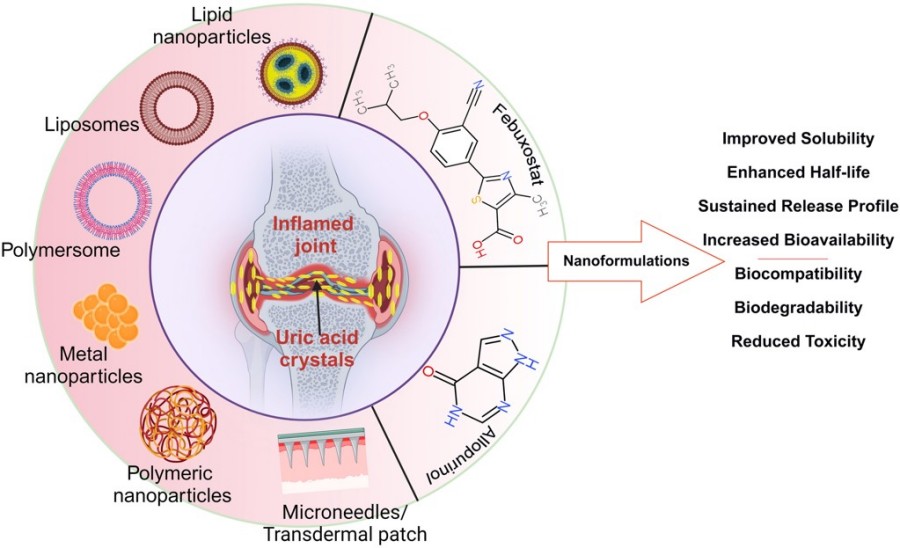Creative Biolabs is dedicated to advancing the field of drug delivery systems. We're glad to present our lipid-based drug delivery systems for hyperuricemia treatment. They can greatly boost the effectiveness and safety of hyperuricemia treatment. We'll fully support researchers in using this technology to break through project limits.
Hyperuricemia, a metabolic disorder characterized by elevated levels of uric acid (UA) in the blood, has gained significant attention in medical research. Long-term hyperuricemia can lead to excessive deposition of urate crystals in joints, kidneys, and other tissues, potentially resulting in complications such as chronic gout and progressive kidney damage. The higher the serum uric acid concentration, the greater the likelihood of gout development.
UA is the final by-product of purine catabolism. Hyperuricemia can result from an imbalance in UA production and excretion, whether it's just one or both factors. Purines from the diet are broken down in the liver through enzymatic reactions, with xanthine oxidase (XO) being one of the key enzymes that facilitate the conversion of purines into UA. The excess UA is then excreted from the body through urine. Effective management of Hyperuricemia requires a multi - faceted approach to address the underlying causes and reduce serum uric acid levels.
Lipid-based drug delivery systems are promising methods in hyperuricemia research. They offer many benefits like better drug solubility, improved bioavailability, longer half-life, sustained release, and targeted delivery. These systems can wrap up hyperuricemia drugs in lipid nanoparticles or liposomes, shielding them from breaking down too soon and ensuring they reach where they're needed in the body. This not only makes treatments more effective but also cuts down on unwanted side effects. It's a real plus for researchers looking into new hyperuricemia therapies.
 Fig. 1 Nanostructures involved in the formulations of allopurinol and febuxostat.1
Fig. 1 Nanostructures involved in the formulations of allopurinol and febuxostat.1
Our liposome can encapsulate a variety of hyperuricemia-related drugs. Whether it's febuxostat or other emerging therapeutic agents, we can optimize their delivery. Visit our lipid-based delivery system development to learn more about how we can customize nanoparticles for your specific drug.
| Category | Drug | Mechanism of Action | Inquiry |
|---|---|---|---|
| UA Synthesis Inhibitors | Allopurinol | Inhibits UA synthesis to reduce serum UA levels. | Inquiry |
| Febuxostat | Specifically inhibits xanthine oxidase activity to lower serum UA levels. | Inquiry | |
| Topiroxostat | Specifically inhibits xanthine oxidase activity to lower serum UA levels. | Inquiry | |
| UA Excretion Promoters | Benzbromarone | Promotes the excretion of UA, thereby effectively reducing blood UA levels. | Inquiry |
| Probenecid | Metabolized in the liver to carboxylic acid and hydroxy compounds, which facilitate UA excretion. | Inquiry |
We offer comprehensive pharmacokinetic and biodistribution analysis for lipid-based hyperuricemia drug delivery systems. This helps researchers understand how the drugs are absorbed, distributed, metabolized, and excreted in the body. We can provide valuable data to guide the optimization of drug formulations.
Lipid-based drug delivery systems represent a significant advancement in hyperuricemia research. At Creative Biolabs, we are proud to offer cutting-edge lipid-based delivery solutions to help researchers overcome challenges and achieve breakthroughs. If you are working on hyperuricemia-related projects and are looking to enhance your drug delivery strategies, we invite you to contact us today. Our team of experts is ready to collaborate with you and provide the support you need to advance your research and make a difference in the field of hyperuricemia treatment.
Reference
 For Research Use Only. Not For Clinical Use
For Research Use Only. Not For Clinical UseApplications
Online Inquiry

